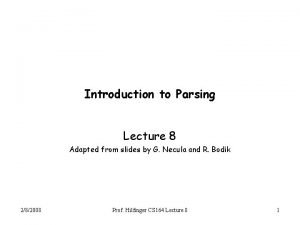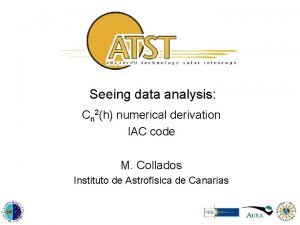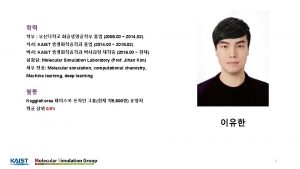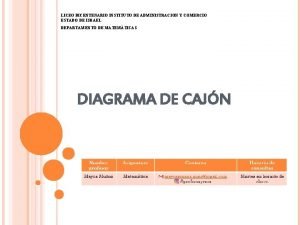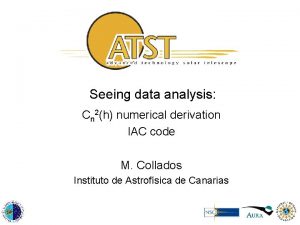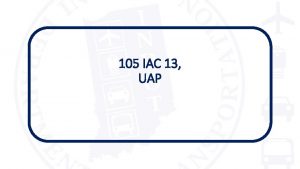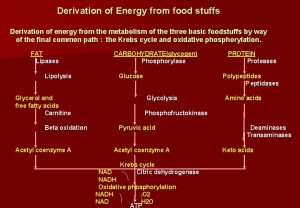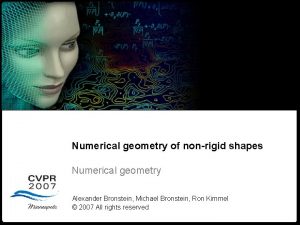Seeing data analysis Cn 2h numerical derivation IAC













- Slides: 13

Seeing data analysis: Cn 2(h) numerical derivation IAC code M. Collados Instituto de Astrofísica de Canarias

Basics • SHABAR cross-covariances (BI(d=0) scintillation): • SDIMM-r 0: z solar zenithal distance

Basics • Cross-covariances

Basics Consequences • SHABAR characteristic height, HSHABAR=1000 cos(z) meters • For turbulence at heights larger than HSHABAR, BI(d) = constant • SHABAR does not allow us to know the position of high altitude turbulence layers ( crucial to get r 0(h) ) • For a given turbulence layer, the higher it is located, the smaller the value of BI. In particular, lower scintillation. • Steeper curves BI(d) imply lower altitude turbulence

Data preparation • BI(dj), j=1, …, 16 dataset from SHABAR and 1 SDIMM-r 0 value stored every 10 s • A five-minute running average (30 samples) is applied to BI(dj, t) and r 0 -5/3(t) to reduce noise. The standard deviation of each parameter is also calculated in the same interval • Bad points are eliminated before averaging (a minimum of 5 good points per block is required)

Numerical solution General numerical strategy • Define N nodes in height where Cn 2(hi) will be determined • Calculate the (linear) interpolation coefficients • Calculate the contribution functions at the nodes for scintillation, cross-covariances and r 0

Numerical solution 2 minimization

Numerical solution Particular numerical strategy • Change of variable Cn 2 (hi) xi such that ( Cn 2 always positive) • Linear interpolation coefficients i(h), i=1, …, N • Standard iterative non-linear least squares minimization algorithm

Numerical solution November 2003 • Scintillation was not included • No sensitivity to the first meter above the instrument

Numerical solution November 2003 Consequence: turbulence located in that first meter reduces the value of r 0 until it matches the observed one. That turbulence is not detected by the other observed parameters This was the case, especially, for the lake sites (Big Bear and Panguitch), where r 0 improved by several cm in just 1 meter above the instrument. Conclusion: include scintillation to gain sensitivity

Numerical solution October 2004 • Scintillation has been included • First meter turbulence has moved to high altitude layers • But …. • Still there are many points where scintillation and r 0 do not seem to be compatible (again, at the lake site). • The observed r 0 is too low (worse seeing than expected), when compared with the low measured scintillation values.

Numerical solution October 2004 A new free parameter has been included: MISSING SCINTILLATION ( s)

Numerical solution October 2004 The interpretation of s difficult: • It must come from high altitude layers (constant for all BI’s) • High altitude turbulence is required to observe a small scintillation and reduce the value of r 0 • Finite outer scale of turbulence? (Wind filtering? ) 1. Large high altitude turbulent eddies produce scintillation (detectable by SHABAR) and global image motion (SDIMM does not measure it). If they are absent, only SHABAR would notice it, giving low scintillation values. 2. Small high altitude turbulent eddies do not produce scintillation (eddy averaging) and generate short spatial scale wavefront deformations (SDIMM detects them)
 Seeing is believing atau believing is seeing
Seeing is believing atau believing is seeing Leftmost derivation and rightmost derivation
Leftmost derivation and rightmost derivation Numerical derivation
Numerical derivation C programming for newton raphson method
C programming for newton raphson method Secondry keywords
Secondry keywords Data augmentation numerical data
Data augmentation numerical data Princeton iac
Princeton iac Cynthia vallerand
Cynthia vallerand Colegio estado de israel coquimbo
Colegio estado de israel coquimbo Iac accreditation checklist
Iac accreditation checklist The iac must ensure custody of air cargo using what methods
The iac must ensure custody of air cargo using what methods Abacaxi gomo de mel
Abacaxi gomo de mel Diagrama de caja
Diagrama de caja Liceo iac coquimbo
Liceo iac coquimbo

